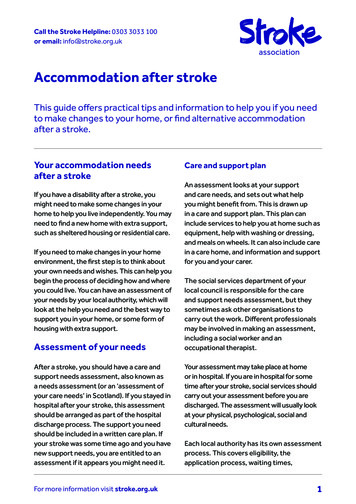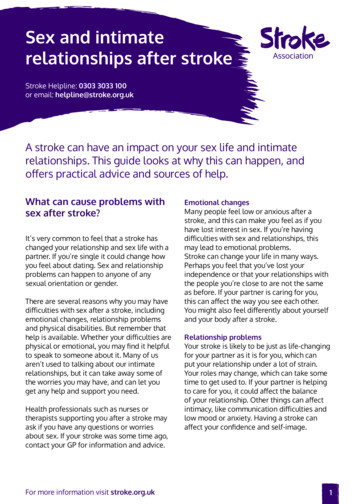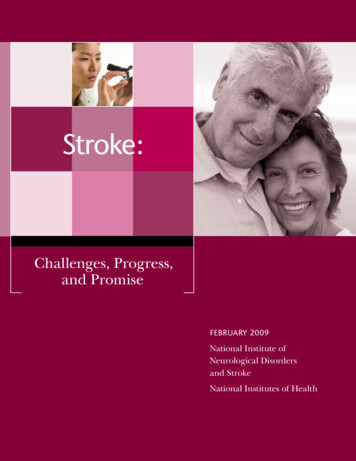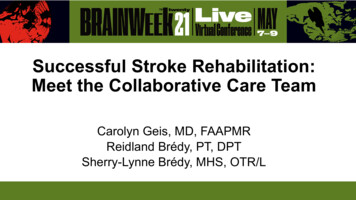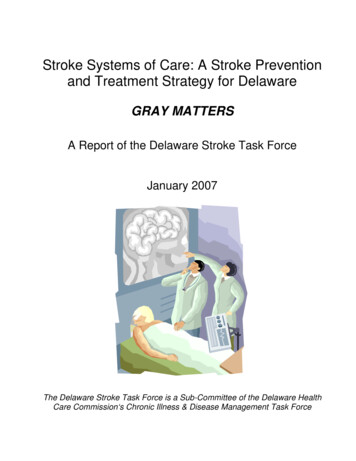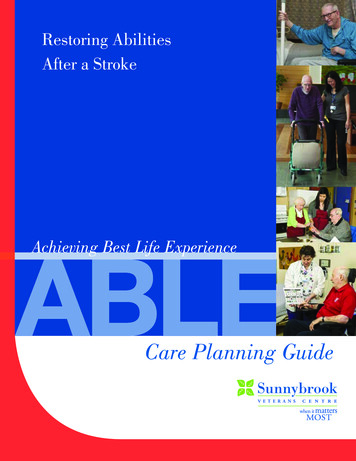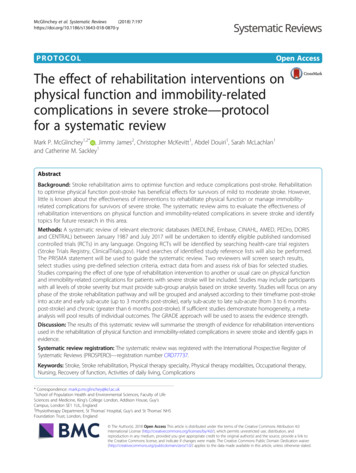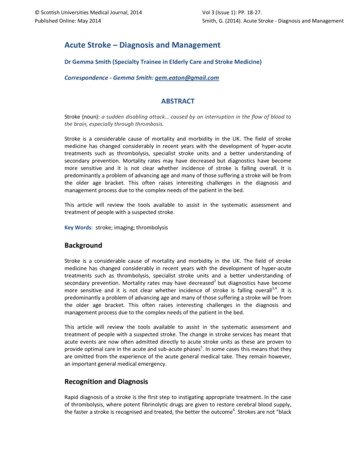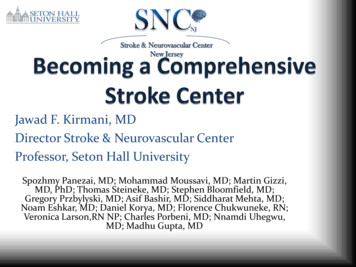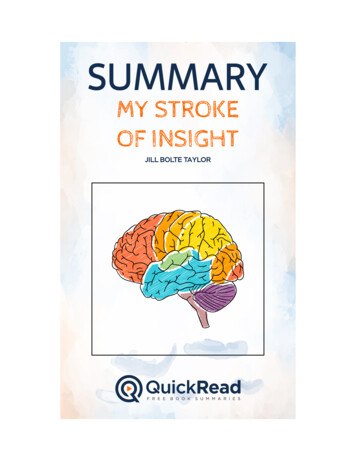
Transcription
Summary of “My Stroke ofInsight” by Jill Bolte TaylorWritten by Lea SchulleryA Brain Scientist’s Personal Journey
Introduction5Bolte Taylor Became Interested in the Brain Early in Life6The Two Types of Strokes9The Differences Between the Left and Right Hemispheres of the Brain11The Morning of the Stroke13The Beginning of Bolte Taylor's Road to Recovery15Bolte Taylor's At-Home Recovery17To Experience Nirvana and Make a Full Recovery, Bolte Taylor NeededSupport and Sleep19Final Summary22
IntroductionOn December 10, 1996, Jill Bolte Taylor experienced a rare form of strokein the left hemisphere of her brain. A major hemorrhage, due to anundiagnosed congenital malformation of the blood vessel in her head,erupted unexpectedly. Within just four hours, her mind completelydeteriorated, and she became unable to walk, talk, read, write, or recall anyof her life. She felt her spirit surrender to death, but after a grueling eightyears, Bolte Taylor made a full recovery. Now, she’s here to tell her personalexperience of achieving insight and developing inner peace throughaccessing her right hemisphere’s consciousness. Additionally, Bolte Taylortells about her fascination with the brain as well as what the stroke taughther about the brain. As a neuroanatomist, she explains just how the strokeled to a step-by-step deterioration of her cognitive abilities and how shesuccessfully recovered. Ultimately, she explains that by the end of themorning of her stroke, Bolte Taylor’s consciousness had shifted into aperception that was one with the universe. Since then, she has come tounderstand how we are capable of having a “mystical” or “metaphysical”experience that relates to achieving inner peace. You too can experience thesame inner peace - without having to experience a stroke! So if you’re readyfor the journey, then let’s begin.
Bolte Taylor Became Interested in the BrainEarly in LifeGrowing up in Terre Haute, Indiana, Bolte Taylor grew up alongside one ofher older brothers with the brain disorder schizophrenia. It was herbrother’s way of experiencing reality that led Bolte Taylor to becomefascinated with the human brain at an early age. She wondered how sheand her brother could share the same experience but walk away withcompletely different interpretations of what had just happened. Thisdifference in perception, information processing, and output motivated herto become a brain scientist.Bolte Taylor craved an understanding of what “normal” was at theneurological level, so she began her academic journey at Indiana Universityin Bloomington, Indiana in the late 1970s. At the time, the subject ofneuroscience was still relatively new so the IU campus didn’t yet offerneuroscience as a formal area of specialization. So she studied bothphysiological psychology and human biology to learn as much as she couldabout the brain. She then began a real job in the world of medical sciencewhen she became a lab technician at the Terre Haute Center for MedicalEducation (THCME). For two years, Bolte Taylor spent her time in themedical human gross anatomy lab and the neuroanatomy research labworking under Dr. Robert C. Murphy, who fostered her love for dissectingthe human body.She then spent the next six years enrolled in the ISU Department of LifeScience Ph.D. program. In 1991, she received her doctorate and beganteaching Human Gross Anatomy, Human Neuroanatomy, and Histology atthe medical school. It was during her studies in 1988 that her brother wasofficially diagnosed with schizophrenia. She aimed to understand why shewas capable of taking her dreams, connecting them to reality, and makingthose dreams come true. Her brother, on the other hand, failed to connecthis dreams to common reality and, instead, they became delusions. After
earning her doctorate, she was then offered a postdoctoral researchposition at Harvard Medical School in the Department of Neuroscience.In 1993, Bolte Taylor landed her dream job of working in the lab of Dr.Francine M. Benes at McLean Hospital. Dr. Benes is a world-renownedexpert in the postmortem investigation of the human brain as it relates toschizophrenia. Francine, whom Bolte Taylor considers the “Queen ofSchizophrenia,” is an amazing research scientist, and as she studied thebrains of those diagnosed with schizophrenia alongside Dr. Benes, shefinally felt a sense of purpose. On her first day, however, Bolte Taylorlearned that there was a shortage of brain donations from families ofindividuals with mental illness. Having just spent the previous week at aconference for NAMI, the National Alliance on Mental Illness, where shemet approximately 1,500 other families like hers, she was surprised to hearabout the lack of donations.She decided this was merely a public awareness issue, so the following yearin 1994, Bolte Taylor was elected to the National NAMI Board of Directors.Of course, the basis of her platform was to raise awareness about the valueof brain donations and the shortage of psychiatrically-diagnosed tissueavailable for scientists to do their work. She called it the “Tissue Issue,” andat just 35-years-old, she became the youngest person elected to the Board ofDirectors. She spent her time raising awareness about brain donationswhile also becoming the Singin’ Scientist. To ease the tension of asking forthe brains of her audience members, she sang The Brain Bank jingle whichmade it okay to communicate her message without completely scaring themaway!Meanwhile, Bolte Taylor was also researching with Dr. Francine Beneslooking to create a protocol where they could visualize threeneurotransmitter systems in the same piece of tissue. Neurotransmittersare the chemicals with which brain cells communicate. The ability tovisualize three systems in the same piece of tissue allowed them to betterunderstand how these systems worked together. This would eventuallyallow them to create better medications for those in need. It was this work
that won Bolte Taylor the prestigious Mysell Award from the HarvardMedical School Department of Psychiatry in 1996. Bolte Taylor was thrivingin her career and helping her NAMI family when the unthinkablehappened. On December 10, 1996, she awoke to discover she wasexperiencing a brain disorder of her own.
The Two Types of StrokesBefore we get into Bolte Taylor’s experience, it’s important to learn what astroke is. You likely know that a stroke involves the brain, but it is also thenumber one disabler in our society and the number three killer. Strokesoccur four times more frequently in the left cerebral hemisphere, which iswhy many stroke-sufferers lose their ability to create or understandlanguage. Lastly, the term stroke refers to a problem with the blood vesselscarrying oxygen to the cells of the brain, and there are essentially two types:ischemic (ih-skee-mik) and hemorrhagic (hem-o-radg-ik).According to the American Stroke Association, ischemic stroke accounts forabout 83% of all strokes. In this type of stroke, blood clots in the artery,preventing oxygen from flowing into the brain’s cells and neurons. You see,arteries carry blood into the brain and their shape becomes smaller andsmaller as they travel further away from the heart. With an ischemic stroke,a blood clot travels into the artery until the tapered diameter of the arterybecomes too small, blocking the flow of oxygen-rich blood to the cellsbeyond the point of obstruction. As a result, brain cells become traumatizedand often die. Unfortunately, neurons do not regenerate and dead neuronscannot be replaced; therefore, the function of deceased cells may be lostpermanently. Over time, other neurons may adapt to carry out theirfunction, but every brain is unique, making recovery unique for everyone.Hemorrhagic stroke occurs when blood escapes from the arteries andfloods the brain. Only 17% of all strokes are hemorrhagic. When this kind ofstroke happens, blood enters the brain and becomes toxic to neurons whenit comes in direct contact with them. An aneurysm can also form whenthere is a weakening in the wall of a blood vessel that will cause the vesselto balloon out. As a result, the weakened area fills with blood and canrupture, spewing large volumes of blood into the skull.An even more rare form of hemorrhagic stroke is called an arteriovenousmalformation or AVM. This is a congenital disorder in which an individual
is born with an abnormal arterial configuration. In the case of AVM, anartery is directly connected to a vein with no buffering capillary bed inbetween, a capillary bed acts as a buffering system between the highpressure arteries and the low-pressure veins. Over time, the vein can nolonger handle the high pressure from the artery, and the connection breaks,resulting in blood spilling into the brain. AVM accounts for only 2% of allhemorrhagic strokes, but it is the most common form of stroke that strikespeople between the ages of 25 and 45. Bolte Taylor was only 37 when herAVM blew. While the mechanical nature of strokes is similar, no twostrokes are the same. No two brains are identical in structure, connections,or the ability to recover. This also means that the symptoms of a stroke canbe different for everyone. Bolte Taylor uses the acronym STROKE toremember the warning signs:S SPEECH, or any problems with languageT TINGLING, or any numbness in the bodyR REMEMBER, or any problems with memoryO OFF BALANCE, problems with coordinationK KILLER HEADACHEE EYES, or any problems with vision
The Differences Between the Left and RightHemispheres of the BrainBefore we move forward with Bolte Taylor’s experience, it’s also importantto understand more about the brain, specifically your left and righthemisphere. Scientists have been studying the human cerebral cortices forover 200 years. It was in the late 1800s when Arthur Ladbroke Wiganwitnessed the autopsy of a man who could walk, talk, read, write, andfunction like a normal man. However, when he examined his brain, Wigandiscovered that the man only had one cerebral hemisphere. As a result,Wigan concluded that people with two hemispheres have two minds and sohe created the “Duality of the Mind” theory.Our right hemisphere, for instance, controls our sensory aspects like sight,smell, taste, and sound. It then combines these and creates a master collageof what you are experiencing moment by moment. Our right mind is alsoresponsible for remembering isolated moments with incredible clarity andaccuracy. It’s the reason many of us can recall where we were or how we feltduring moments like the assassination of President Kennedy or the collapseof the World Trade Center. Additionally, the right mind isn’t involved withtime, it solely focuses on the present moment. This is why our right mind isspontaneous, carefree, and imaginative. This is also the reason our rightbrain can perceive the bigger picture of how everything in this world isrelated, and how we all join together to make up the whole. It’s alsoresponsible for our ability to be empathetic and to walk in the shoes ofanother and feel their feelings.On the other hand, the left hemisphere focuses on language, numbers,patterns, and categories. It processes information differently by takingthose rich and complex moments created by the right hemisphere andstringing them together in a timely succession. By linearly organizingdetails, our left brain manifests the concept of time and divides momentsinto the past, present, and future. It is the left brain that allows you to lookat your shoes and socks and comprehend that you must put on your socks
before your shoes. Additionally, it builds an understanding of everythingusing deductive reasoning, such as “If A is greater than B, and B is greaterthan C, then A must be greater than C.”While the two cerebral hemispheres process information in unique ways,they work together in just about every action we take. For example, when itcomes to language, our left hemisphere understands the details making upthe sentence and the meaning of the words. It understands what letters areand how they fit together to create words and meaning. Our righthemisphere complements the left by interpreting non-verbalcommunication. Our right mind evaluates the subtle cues of language, suchas tone of voice, facial expression, and body language. This means thatthose with left hemisphere damage typically cannot create or understandspeech because the cells in their language centers have been injured. On theother hand, if someone has damage in their right hemisphere, they may notbe able to determine the emotional content of a message and interpreteverything literally.
The Morning of the StrokeAt 7:00 a.m. on December 10, 1996, Bolte Taylor woke up to a sharp painpiercing her brain behind her left eye. She switched off her alarm andthought about how strange it was to awake with such striking pain since shehardly ever gets sick. She felt sensitive to light, so she stumbled to thebedroom window and closed it to block the stream of light from streaminginto her eyes. Despite the pain she was in, she decided exercise might helpget her blood flowing and dispel the pain.As she hopped onto her “cardio-glider,” she felt a powerful and unusualsense of dissociation swarm her. She questioned her well-being, herthoughts seemed lucid, and her body felt irregular. As she watched her bodymove on the machine, she felt strangely detached from her normalcognitive function. She was certain that she wasn’t dreaming, yet shedescribes feeling trapped inside the perception of meditation that she couldneither stop nor escape. She simply felt dazed and her head continued topound. Perhaps exercise wasn’t such a great idea.Feeling a bit nervous, she climbed off the machine and bumbled her way tothe bath. She felt her movements no longer become fluid; instead, theyseemed jerky and there was nothing graceful about them. She was losingher balance and her mind seemed preoccupied with keeping her bodyupright. As she turned on the faucet, she became startled by the suddensurge of water into the tub. This amplification of sound brought BolteTaylor to the realization that she was having problems with coordinationand equilibrium. For the first time, she considered the possibility of a majorneurological malfunction that was life-threatening.As her brain searched for an explanation for what was happening, shenoticed that the constant brain chatter in her mind was no longer aconstant flow of conversation; instead, her verbal thoughts becameinconsistent, fragmented, and interrupted by periods of silence. Evenworse, the harder she tried to concentrate, the more fleeting her ideas
seemed to be. She became detached from her life and was finding anincreasing sense of peace and calm. In the absence of her brain chatter, hermemories of the past and her dreams of the future evaporated with them.She was alone.The growing void was seductive as she welcomed the reprieve that thesilence brought. However, the water pounding on her body startled herback into reality, and she quickly understood that she was in grave danger.She decided to get ready for work, and as she did so, her body felt unsteadyand heavy. Her motions were slow and drawn-out. She then started to thinkabout going to work and the route to get there. Could she even drive? Atthat moment, her right arm dropped completely paralyzed against her side.She recognized then that she was having a stroke. She felt strangelyeuphoric and simply wanted to lie down and relax. But her cognitive mindkept telling her that if she lied down, she would never get up.As her left hemisphere was failing her, Bolte Taylor struggled to call forhelp. She simply tried to sit and wait for a moment of clarity that wouldpermit her mind to connect her thoughts and execute a plan. She satthinking, “What am I doing? Call for help. Call for help. I’m trying to call forhelp.” In a moment of clarity, she decided to call her colleagues at work, buther mind wouldn’t recall the number for her. She stared at the keypad ofthe phone hoping the numbers would come to her. Suddenly, four digitsappeared in her mind.2405. She picked up a pen with her non-dominantleft hand and jotted down the images in her mind. The process of calling forhelp took her about 45 minutes, and during her next moment of clarity, shecalled her colleague and friend, Dr. Stephen Vincent.When he answered, she quickly realized that she could no longerunderstand speech or hardly even speak. She quickly blurted, “This is Jill. Ineed help!” Of course, it didn’t quite come out that way. Instead, it wasmore just grunts and groans, but fortunately, Steve recognized her voiceand understood that she was in grave danger. Finally, Bolte Taylor couldrelax as she understood there was nothing more she could do to saveherself.
The Beginning of Bolte Taylor's Road toRecoveryIn the first 48 hours in the hospital, Bolte Taylor was given numerousneurological exams. During these examinations, she shifted entirely to herright hemisphere as her left hemisphere became a pool of blood. With thisshift, she became empathetic to others. She couldn’t understand what theywere saying, but she could read their facial expressions and body languagemore strongly than she ever could in the past. Even more, she realized thatsome people brought energy while others took it away.For instance, one nurse was incredibly attentive to her needs, ensuring shewas warm enough, hydrated enough, or in pain. This nurse made her feelsafe by making eye contact and providing her with a healing space. Anothernurse, however, never made eye contact and shuffled her feet as though shewere in pain. She brought Bolte Taylor a tray with milk and jello but failedto realize that her hands and fingers couldn’t open containers. This nursewas oblivious to her needs and didn’t care to connect with her patient. As aresult, Bolte Taylor did not feel safe in her care. Dr. David Greer was kind,gentle, and sympathetic to her situation. He took the time to pause his dayand softly speak to her. While she could not understand his words, sheunderstood that he was caring for her. She felt respect and kindnesstowards him.Bolte Taylor quickly realized that rehabilitation was completely in hercontrol, it was her decision to show up or not. Those that came to her withpatience and kindness, she put forth the effort to connect and makeprogress. Those that came in solely to sap her energy were ignored as shetried to protect herself from them. Deciding to recover, however, was anincredibly difficult one. She enjoyed the bliss of drifting in and out of theeternal flow; it was beautiful, peaceful, and free. But three days after herstroke, her doctors looked at the results of her angiogram, the X-ray, to seethe blood vessels in the brain to identify the type of stroke. For Bolte Taylor,she had suffered a hemorrhagic stroke caused by an undiagnosed
arteriovenous malformation. If action wasn't taken soon, she could sufferanother stroke, and the next time, she might not be so lucky.Dr. Ogilvy described the problems with the blood vessels in her brain andsuggested that Bolte Taylor should have a craniotomy to remove theremnants of the ATV and a clot the size of a golf ball. After someconvincing, she agreed to have the surgery. However, she needed to get herbody strong enough over the next few weeks to survive the dangerous,invasive surgery. She learned that she needed to put forth the effort if shewanted to make any progress. For example, one day she rocked back andforth several times before being able to roll upward. In her stage of rocking,she recognized that rocking was the only activity that mattered. She simplyfocused on breaking down her actions into smaller steps; otherwise, shewould have become disappointed and given up.On her fifth day, it became time for Bolte Taylor to go home and continueworking on her strength to endure surgery. A physical therapist taught herhow to climb a stair, with support, and she was released into the care of hermother.
Bolte Taylor's At-Home RecoveryWhile in the care of her mother, Bolte Taylor was essentially like an infantagain, learning virtually everything from scratch. How to walk. How to talk.How to read, write, put a puzzle together, etc. To recover, she would need togo through each motion step-by-step, mastering each step before movingon to the next. She had learned to rock and then roll before sitting up, shethen had to sit up and rock forward before she could stand. She had tostand before she could take the first step, and she had to be relatively stableon her feet before she could climb a stair by herself. Most importantly, shehad to be willing to try. She had to convince her brain that she needed thisrecovery.Her mother began the process of walking Bolte Taylor back and forthbetween her bed and the bathroom. After that exercise, she would sleep forsix hours. That was all she could do for the first few days! Once shemastered the trek to the bathroom, she headed for the living room couchwhere she could sit up and eat food. Of course, she had to re-learn how touse utensils too. But the key to her successful recovery was her mother’spatience. She would constantly remind her of her small successes andunderstood the importance of celebrating all her accomplishments. Strokesurvivors oftentimes complain about no longer recovering, but perhaps thereal problem is that no one is paying attention to the little accomplishmentsthat are being made.Eventually, Bolte Taylor began completing children’s puzzles and games tohelp stimulate her brain. With her first puzzle, her mother explained howthe puzzle would fit together to create an entire picture. Her first task wasto turn all the pieces right side up. Bolte Taylor replied, “What is right sideup?” Her mother showed her and once she understood the difference, sheinspected each piece until all 12 pieces were right side up. She did it! Next,she needed to pick out which pieces had an edge. After explaining what anedge is, Bolte Taylor successfully separated all the edges. She was theninstructed to take the “outsy” pieces and hook them together with the “insy”
pieces. Simply holding the pieces took extreme effort, and she was failing toput the pieces together.Her mother finally told her, “Jill, you can use color as a clue.” Suddenly, alight bulb went off in her head, and she could suddenly see color again! Atthat point, she was so worn out that she had to sleep before attempting thepuzzle again. The next day, she went back to that puzzle and put all thepieces together using color as a clue. Bolte Taylor is still fascinated that shecould not see colors until she was told that color was a tool that she couldsee. But perhaps the hardest thing that she had to re-learn was reading. Toher, she had no recollection that reading was something she had ever donebefore, it was simply an abstract idea that she couldn’t believe anyone hadever thought of.Her mother sat down with her with a book titled The Puppy Who Wanted aBoy, and together they attempted to make sense of the written word. ToBolte Taylor, an “S” was a squiggle that made no sound and certainly didn’tmake an “SSSS” sound. She then had to understand that every squiggle hada name and an associated sound. Those combinations of squiggles then fittogether to form special combinations of sounds, like “sh” and “th.” Whenyou string all those combinations together, they make a word, and thatword then has a meaning! Although it was a struggle, she began to makeobvious progress and continued to celebrate her accomplishments, andeventually, she became ready for surgery.
To Experience Nirvana and Make a FullRecovery, Bolte Taylor Needed Support andSleepOn December 27, 1996, Bolte Taylor marched into Massachusetts GeneralHospital to have her head cut open. One of the last things she remembersbefore being knocked out was telling Dr. Ogilvy, “Hey Doc, I’m 37 andsingle; please don’t leave me totally bald!” After waking up, she discoveredthat the left third of her head had been shaved and a nine-inch upsidedown “U” shaped scar ran from the front of her ear to the back of her head.The good news though? She was able to speak again! It was during herrecovery from surgery that Bolte Taylor had several epiphanies about herexperience and life in general.First, she realized what she needed to successfully recover, and that was tobe surrounded by those who believed in her recovery and in her success.Recovery was a decision that she had to make a million times a day, and sheconstantly questioned whether she was willing to give up her newly foundbliss to try and understand the complicated external world. In the absenceof her left hemisphere, she was left to experience the Nirvana in theconsciousness of her right hemisphere. Her stroke of insight was: “peace isonly a thought away, and all we have to do to access it is silence the voiceof our dominating left mind.”Recovery for her was that she needed people to treat her as though shewould recover completely, no matter how long it would take. She thenheard doctors tell her, “If you don’t have your abilities back by six monthsafter your stroke, then you won’t get them back!” This, however, is untrue.She noticed an improvement in her brain’s ability to learn and function foreight years after her stroke, at which point she decided her mind and bodywere totally recovered. This can be attributed to the plasticity of the brain,and the ability for the brain to change its neural connections and regain
some of the functions she lost. She needed the people around her to believein the plasticity of her brain and its ability to grow, learn, and recover.Next, Bolte Taylor needed to rely on the healing power of sleep. For her,sleep was “filling time,” in which her brain could recover from the energyher brain expelled when awake. While awake, her neurons couldn’t keep upwith the demand needed of her, and her brain needed to be protected, andisolated from obnoxious sensory stimulation. If she didn’t respect herbrain’s need for sleep, her sensory systems would experience pain and shewould become both psychologically and physically depleted. As a result, shewould have tried less to recover. Sleep helped her recover and gave her themotivation to try harder to succeed.Bolte Taylor also realized that through her experience, she could helpothers achieve the peace and Nirvana that she had in the momentsfollowing her stroke. Thanks to her stroke, Bolte Taylor was able to explorethe world again with a childlike curiosity. In the consciousness of her rightmind, she was adventurous, celebrative of abundance, and socially adept.She became sensitive to nonverbal communication, empathic, andaccurately decoded emotion. You too can access this part of your mindwithout going through the experience of having a life-threatening stroke!The first step is to come back to the present moment. To do this, you mustconsciously slow down your mind by first deciding that you are not in ahurry. “Your left mind may be rushing, thinking, deliberating, andanalyzing but your right mind is very m-e-l-l-o-w.”To unlock her own inner peace, Bolte Taylor looks at how her bodyorganizes information into systems and capitalizes on those alreadyestablished circuits. Therefore, she pays attention to sensory information asit streams into her body and repeatedly asks herself, “how does it feel to behere doing this?” Begin by simply paying attention to your eating anddrinking. Pay attention to the textures of different foods and how they feelin your mouth. What foods would you classify as fun food and why? ForBolte Taylor, she loves chasing around gelatin balls in tapioca pudding or
spaghetti. Essentially, you should get in touch with your senses. What areyou feeling? Tasting? Seeing?For Bolte Taylor, she imagines her mind as a garden, a sacred piece ofcosmic real estate that the universe has entrusted her to tend over the yearsof her lifetime. She consciously chooses to nurture the particular circuitsshe wishes to grow and prunes back the ones she prefers to live without. Itmay be easier to nip a weed when it is only a sprouting bud, but withdetermination and perseverance, even the most overgrown vines can loseits strength and fall to the side by simply failing to give it fuel. Of course,western civilization makes it hard to access the right hemisphere, but theright brain consciousness is eager for us to take the next leap for mankind.We have the power to evolve this planet into a peaceful and loving place. Sopay attention to what is going on in your brain, own your power, and showup for your life.
Final SummaryWhen Jill Bolte Taylor experienced a stroke at just 37-years-old, she had tolearn everything again from scratch: how to walk, talk, read, and speak. Itwas during her recovery, however, that she experienced life in only the righthemisphere. It was a place of peacefulness and tranquility, she didn’t careabout what people thought of her and the chatter in her brain becamesilent. Through perseverance and a lot of patience, she was able to make afull recovery. But to this day, she still takes a step to the right andconsciously accesses her right brain to feel that sense of calm and peace intoday’s fast-paced world. Ultimately, experiencing a life-altering strokeallowed Bolte Taylor to find Nirvana and think differently about life.
language. Lastly, the term stroke refers to a problem with the blood vessels carrying oxygen to the cells of the brain, and there are essentially two types: ischemic (ih-skee-mik) and hemorrhagic (hem-o-radg-ik). According to the American Stroke Association, ischemic stroke accounts for about 83% of all strokes.
